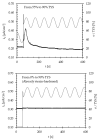Hydrogen Permeation in X65 Steel under Cyclic Loading
- PMID: 32429576
- PMCID: PMC7287996
- DOI: 10.3390/ma13102309
Hydrogen Permeation in X65 Steel under Cyclic Loading
Abstract
This experimental work analyzes the hydrogen embrittlement mechanism in quenched and tempered low-alloyed steels. Experimental tests were performed to study hydrogen diffusion under applied cyclic loading. The permeation curves were fitted by considering literature models in order to evaluate the role of trapping-both reversible and irreversible-on the diffusion mechanism. Under loading conditions, a marked shift to the right of the permeation curves was noticed mainly at values exceeding the tensile yield stress. In the presence of a relevant plastic strain, the curve changes due to the presence of irreversible traps, which efficiently subtract diffusible atomic hydrogen. A significant reduction in the apparent diffusion coefficient and a considerable increase in the number of traps were noticed as the maximum load exceeded the yield strength. Cyclic loading at a tensile stress slightly higher than the yield strength of the material increases the hydrogen entrapment phenomena. The tensile stress causes a marked and instant reduction in the concentration of mobile hydrogen within the metal lattice from 55% of the yield strength, and it increases significantly in the plastic field.
Keywords: cathodic protection; elasto–plastic deformation; hydrogen permeation; low-alloyed steel.
Conflict of interest statement
The authors declare no conflict of interest.
Figures










References
-
- Eliassen S. New concept for cathodic protection of offshore pipelines to reduce hydrogen induced stress cracking (HISC) in high strength 13%Cr stainless steels. Corros. Eng. Sci. Technol. 2004;39:31–37. doi: 10.1179/147842204225016868. - DOI
-
- Orazem M.E., Esteban J.M., Kennelley K.J., Degerstedt R.M. Mathematical Models for Cathodic Protection of an Underground Pipeline with Coating Holidays: Part 1—Theoretical Development. Corrosion. 1997;53:264–272. doi: 10.5006/1.3280467. - DOI
-
- Kang D.H., Lee J.K., Kim T.W. Corrosion fatigue crack propagation of high-strength steel HSB800 in a seawater environment. Procedia Eng. 2011;10:1170–1175. doi: 10.1016/j.proeng.2011.04.195. - DOI
-
- Cheng A., Chen N.Z. An extended engineering critical assessment for corrosion fatigue of subsea pipeline steels. Eng. Fail. Anal. 2018;84:262–275. doi: 10.1016/j.engfailanal.2017.11.012. - DOI
-
- Knop M., Heath J., Sterjovski Z., Lynch S.P. Effects of cycle frequency on corrosion-fatigue crack growth in cathodically protected high-strength steels. Procedia Eng. 2010;2:1243–1252. doi: 10.1016/j.proeng.2010.03.135. - DOI
LinkOut - more resources
Full Text Sources

